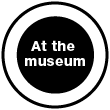|
 Dr. Ames' Enchanted Room Dr. Ames' Enchanted Room
The display is a Distorted Wall in a room. A camera and a screen are located in front of the wall in a specific distance. Visitors stand behind the screen and experience an awesome size illusion.
The brain relies on hints from the environment to estimate the size and distance of the images it perceives..
The camera, is operating like closing one eye, removes the hints regarding the three-dimensional structure of the room. The brain assumes, mistakenly, that it is looking at a normal wall of a room with equal-sized windows. The figures on the wall appear to be the same size though they are not.
The original Ames Room was constructed by Albert Ames, Jr., an optician, in 1946.
The room actually creates two different illusions:
The Wall Illusion
The wall appears to be rectangular, even though it is not. It is specially constructed so that the picture created on the retina is identical to the picture that a normal wall would create. We interpret the picture on the retina as a rectangular wall. This illusion is frequently used to demonstrate how the brain relies on its experience when it "chooses" one interpretation among several possible alternatives. However, this does not explain why the illusion works even with people from cultures that do not have rectangular rooms!
The Size Illusion
People of the same size standing in this room appear to be quite different in size. The images on the retina are of different sizes because these images lie at different distances from us. We perceive them as actually having different sizes because we compare them with the walls and windows, as well as with each other. Some claim that it's not necessary to use a distorted room to create this image. (One example is the Size Doesn't Matter illusion).
Did you know? Some researchers claim that the size distortion from one corner of the room to another is less when the person we're looking at is someone we know and love. Try it!
Links:
The Wikipedia definition: http://en.wikipedia.org/wiki/Ames_room
An excellent website offering different interpretation of the illusion, criticism of the standard explanation, and a bibliography:
http://www.psychologie.tu-dresden.de/i1/kaw/diverses%20Material/www.illusionworks.com/html/ames_room.html
Related exhibits:
Chairs from Wonderland
Size Doesn't Matter
Twin Tables
|






 Dr. Ames' Enchanted Room
Dr. Ames' Enchanted Room